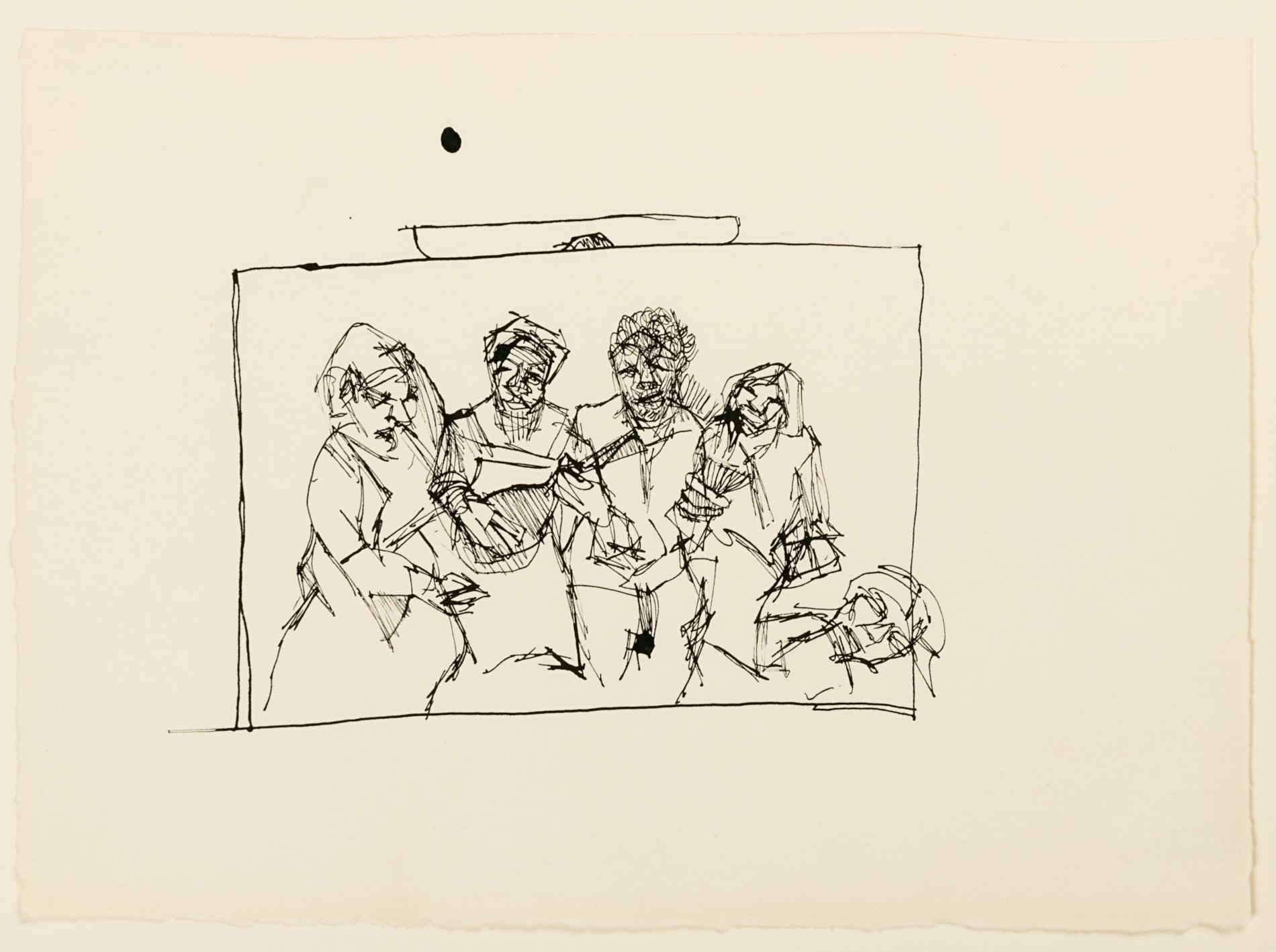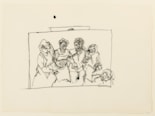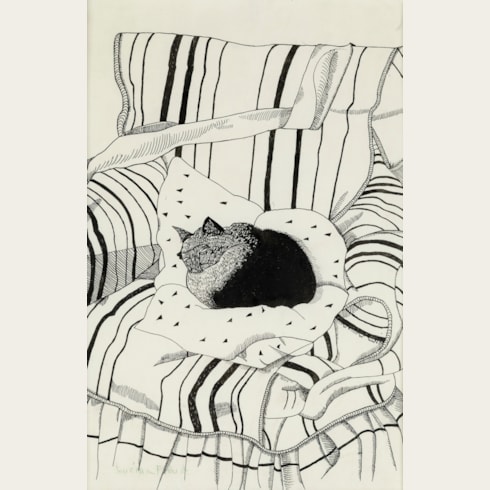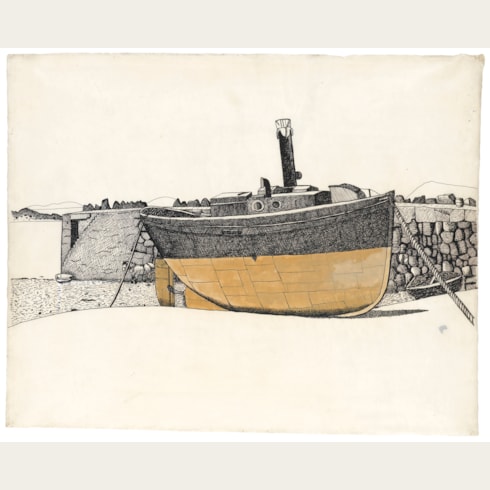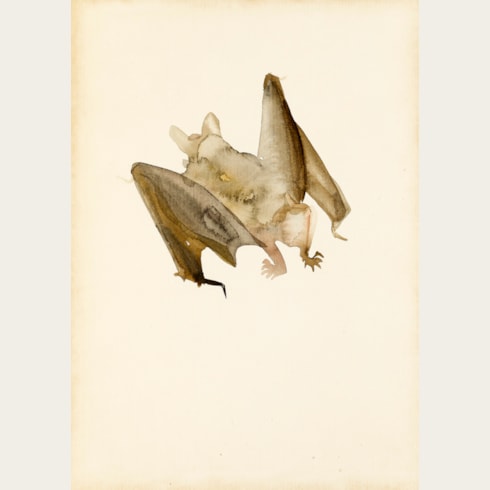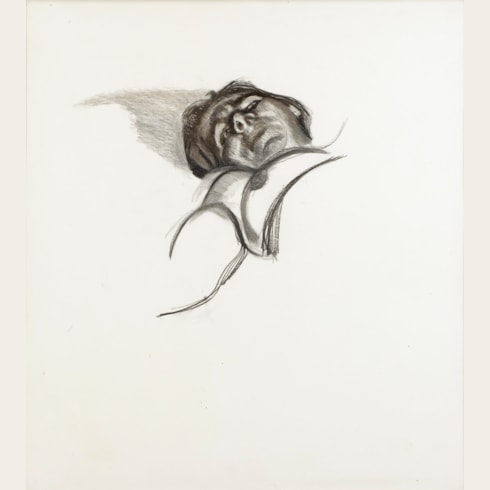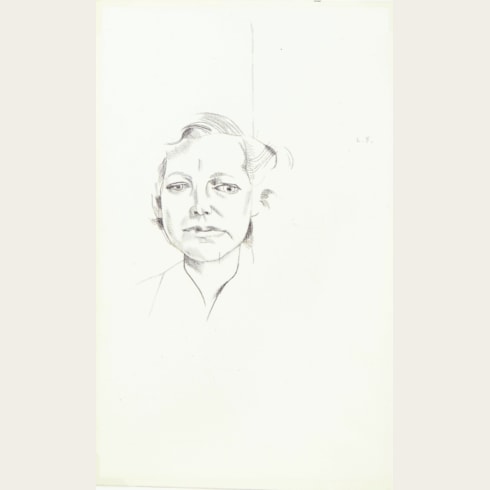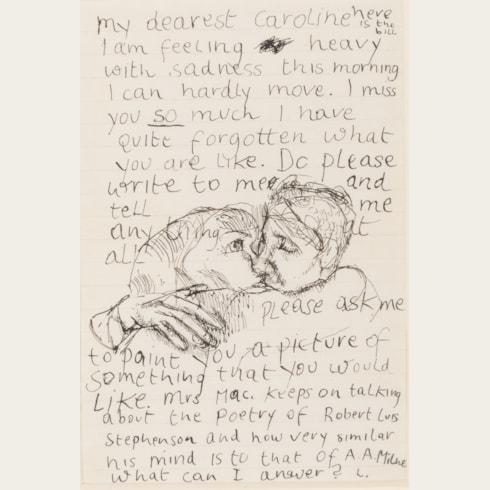Lucian FREUD
(Berlin 1922 - London 2011)
Drawing after Large Interior W11 (after Watteau)
Pen and black ink.
240 x 333 mm. (9 1/2 x 13 1/8 in.) [sheet]
240 x 333 mm. (9 1/2 x 13 1/8 in.) [sheet]
This is one of a number of drawings by Lucian Freud related to one of his most important and ambitious paintings, Large Interior W11 (after Watteau), formerly in the collection of the late Paul Allen and recently sold at auction. Freud worked on the sizeable canvas between 1981 and 1983 in his spacious studio in Holland Park in West London, to which he had moved in 1977, and which allowed him to work on a larger scale than before. This group portrait, painted on a canvas measuring over six feet square, depicts four adult figures well known to the artist; from left to right, Freud’s lover, the painter Celia Paul, his daughter Bella playing the mandolin, the artist’s stepson Kai Boyt (a replacement for his son Ali Boyt, who had decided not to continue posing), and Kai and Ali’s mother Suzy Boyt. Lying on the floor is a child named Star, the little sister of Ali Boyt’s girlfriend. (Star was a replacement for Freud’s granddaughter May, whose mother Annie refused to let her pose.) As the artist said, ‘I took a while setting it up. It took quite a lot of staging. I’d been making drawings with the idea of doing a group painting, which I’d never done…It’s the nearest thing I have ever come to casting people rather than painting them, but they’re still portraits, really. They are also characters. A slight bit of role playing they are doing, but I didn’t try to forget who they were. In the end they are just there.’
Upon its completion, the large painting was purchased by the artist’s dealer and agent James Kirkman, and was shown at Agnew’s gallery in London in November 1983, alongside several related drawings. Offered unsuccessfully by Kirkman to the Tate Gallery for £250,000, Large Interior W11 (after Watteau) then remained in his personal collection until it was sold by him at auction in New York in 1998, when it was acquired by Paul Allen, underbid by the National Gallery of Australia.
The composition of Large Interior W11 (after Watteau) was inspired by a small painting entitled Pierrot Content by the 18th century French artist Jean-Antoine Watteau. Datable to c.1712, the fête galante painting belonged to Baron Hans Heinrich Thyssen-Bornemisza and is today in the Thyssen-Bornemisza Museum in Madrid. Freud had a reproduction of Watteau’s painting pinned to the wall of his studio, and drew a large-scale pastel copy after Pierrot Content, now in a private collection, in which he retained the poses and costumes of Watteau’s figures but altered their faces. He likewise placed a reproduction of the picture in the background of his portrait of Baron Thyssen, painted between 1981 and 1982 and also now in the Thyssen-Bornemisza Museum. As the artist recalled of the Watteau image, ‘Thyssen gave me his catalogue and got me a photograph and I got someone to blow it up; I didn’t see the picture till years later; it’s a lovely little picture.’
As the Freud scholar and biographer William Feaver has written of Large Interior W11 (after Watteau), ‘The most elaborate test of the [new] studio…was a re-enactment there, on a hugely enlarged scale, of a Watteau, Pierrot Content, owned by Thyssen. Freud knew the picture only from a reproduction but that was enough to spark his interest in the idea of translating a frenchified commedia dell’arte tableau set in a dark glade into a contemporary gathering set at rooftop level. He began thinking that, having had trouble raising his left arm – his painting arm – above shoulder height, this was likely to be his last chance of producing a really large picture. Those he involved in Large Interior W11 (after Watteau)…were, he said, “people I knew (and would sit), and I liked working from.” He brought together a mother and son, a daughter, a girlfriend and fellow painter…and the sulky substitute for a grandchild he had wanted to include…Posed under the skylight in summer clothing, hands arranged, feet slightly choreographed, grouped in front of tangled verbena plants, they were required to be simply themselves à la Watteau. The only sound was to be a running tap, in lieu of Watteau’s sprinkling fountain.’
Catherine Lampert has noted of the painting that, ‘As Freud was arranging the five people, he did so in a way which exposed his influence over them, from the costumes they put on to the fact of sitting closely together on a bed and ‘sharing’ their relationship with the artist standing a few paces away…The proscenium effect of the floorboards contributes to the mirage-like effect, credible and vulnerable, whereas the plain functionality of the setting makes the costumes seem more like those from an attic trunk and an acknowledgement that the gathering was not an enchanted interlude. Indeed, insecurity spreads over the whole of Large Interior, from the people to the running water and the empty space.’
The present sheet is one of several drawings by Freud – executed in pen and ink, pastel or charcoal – that appear to be inspired by the finished painting of Large Interior W11 (after Watteau), rather than preparatory studies for it. Some of these drawings, including this one, depict the painting on an easel; one particularly finished and colourful example, which incorporates a view of the studio itself, is today in the Katrin Bellinger collection in London.
As Sebastian Smee has noted, ‘Of the extant drawings on paper since Freud resumed etching, the most fascinating examples are those he did in connection with his most ambitious painting of the 1980s, Large Interior W11 (after Watteau), 1981-3. Intriguingly, most of these were made after the painting was finished or as it neared completion; they were not preparatory studies. They explored aspects of the painting from different angles and different degrees of proximity…The cumulative effect of the After Watteau drawings is odd. It’s almost as if, as Freud came closer to finishing the large painting, he became increasingly beguiled by it – not so much by its technical side, as by the dizzying game it plays with fiction and truth. The original Watteau functions for Freud as a kind of scaffolding in Large Interior W11. His treatment of it – reducing its rich load of historical meaning and delicate emotion to a mere bit of frippery in which no one, not even the actors, believes – encourages this scaffolding to fall away in the viewer’s imagination. The result, paradoxically, is that the sitters – monumentalised, their bodies expressing nothing beyond the bedrock reality of holding a pose in the artist’s studio – are freed from any constructed fiction, and graced with a new depth of human freedom…Augmenting the painting, the associated drawings add to the beguilement of artifice and reality; they possess something of the magic of dress rehearsals on the eve of opening night.’
With particular reference to the painting Large Interior W11 (after Watteau), another scholar, Robert Flynn Johnson, has written that ‘Freud does not work from preliminary studies: instead, he draws his composition with charcoal directly on the canvas, effacing it as the painting proceeds. Freud executed a number of impressive drawings based on elements of this work, yet they were all done after the painting was completed. It is fascinating that Freud reverses the traditional artistic method of working from studies to a finished whole. He completes the work, then takes fragments out of the composition to be used in drawings that stand alone as independent works of art.’ Other drawings by Freud related to Large Interior W11 (after Watteau) – some of which may have come from the same sketchbook as the present sheet – are in a number of private collections.
Upon its completion, the large painting was purchased by the artist’s dealer and agent James Kirkman, and was shown at Agnew’s gallery in London in November 1983, alongside several related drawings. Offered unsuccessfully by Kirkman to the Tate Gallery for £250,000, Large Interior W11 (after Watteau) then remained in his personal collection until it was sold by him at auction in New York in 1998, when it was acquired by Paul Allen, underbid by the National Gallery of Australia.
The composition of Large Interior W11 (after Watteau) was inspired by a small painting entitled Pierrot Content by the 18th century French artist Jean-Antoine Watteau. Datable to c.1712, the fête galante painting belonged to Baron Hans Heinrich Thyssen-Bornemisza and is today in the Thyssen-Bornemisza Museum in Madrid. Freud had a reproduction of Watteau’s painting pinned to the wall of his studio, and drew a large-scale pastel copy after Pierrot Content, now in a private collection, in which he retained the poses and costumes of Watteau’s figures but altered their faces. He likewise placed a reproduction of the picture in the background of his portrait of Baron Thyssen, painted between 1981 and 1982 and also now in the Thyssen-Bornemisza Museum. As the artist recalled of the Watteau image, ‘Thyssen gave me his catalogue and got me a photograph and I got someone to blow it up; I didn’t see the picture till years later; it’s a lovely little picture.’
As the Freud scholar and biographer William Feaver has written of Large Interior W11 (after Watteau), ‘The most elaborate test of the [new] studio…was a re-enactment there, on a hugely enlarged scale, of a Watteau, Pierrot Content, owned by Thyssen. Freud knew the picture only from a reproduction but that was enough to spark his interest in the idea of translating a frenchified commedia dell’arte tableau set in a dark glade into a contemporary gathering set at rooftop level. He began thinking that, having had trouble raising his left arm – his painting arm – above shoulder height, this was likely to be his last chance of producing a really large picture. Those he involved in Large Interior W11 (after Watteau)…were, he said, “people I knew (and would sit), and I liked working from.” He brought together a mother and son, a daughter, a girlfriend and fellow painter…and the sulky substitute for a grandchild he had wanted to include…Posed under the skylight in summer clothing, hands arranged, feet slightly choreographed, grouped in front of tangled verbena plants, they were required to be simply themselves à la Watteau. The only sound was to be a running tap, in lieu of Watteau’s sprinkling fountain.’
Catherine Lampert has noted of the painting that, ‘As Freud was arranging the five people, he did so in a way which exposed his influence over them, from the costumes they put on to the fact of sitting closely together on a bed and ‘sharing’ their relationship with the artist standing a few paces away…The proscenium effect of the floorboards contributes to the mirage-like effect, credible and vulnerable, whereas the plain functionality of the setting makes the costumes seem more like those from an attic trunk and an acknowledgement that the gathering was not an enchanted interlude. Indeed, insecurity spreads over the whole of Large Interior, from the people to the running water and the empty space.’
The present sheet is one of several drawings by Freud – executed in pen and ink, pastel or charcoal – that appear to be inspired by the finished painting of Large Interior W11 (after Watteau), rather than preparatory studies for it. Some of these drawings, including this one, depict the painting on an easel; one particularly finished and colourful example, which incorporates a view of the studio itself, is today in the Katrin Bellinger collection in London.
As Sebastian Smee has noted, ‘Of the extant drawings on paper since Freud resumed etching, the most fascinating examples are those he did in connection with his most ambitious painting of the 1980s, Large Interior W11 (after Watteau), 1981-3. Intriguingly, most of these were made after the painting was finished or as it neared completion; they were not preparatory studies. They explored aspects of the painting from different angles and different degrees of proximity…The cumulative effect of the After Watteau drawings is odd. It’s almost as if, as Freud came closer to finishing the large painting, he became increasingly beguiled by it – not so much by its technical side, as by the dizzying game it plays with fiction and truth. The original Watteau functions for Freud as a kind of scaffolding in Large Interior W11. His treatment of it – reducing its rich load of historical meaning and delicate emotion to a mere bit of frippery in which no one, not even the actors, believes – encourages this scaffolding to fall away in the viewer’s imagination. The result, paradoxically, is that the sitters – monumentalised, their bodies expressing nothing beyond the bedrock reality of holding a pose in the artist’s studio – are freed from any constructed fiction, and graced with a new depth of human freedom…Augmenting the painting, the associated drawings add to the beguilement of artifice and reality; they possess something of the magic of dress rehearsals on the eve of opening night.’
With particular reference to the painting Large Interior W11 (after Watteau), another scholar, Robert Flynn Johnson, has written that ‘Freud does not work from preliminary studies: instead, he draws his composition with charcoal directly on the canvas, effacing it as the painting proceeds. Freud executed a number of impressive drawings based on elements of this work, yet they were all done after the painting was completed. It is fascinating that Freud reverses the traditional artistic method of working from studies to a finished whole. He completes the work, then takes fragments out of the composition to be used in drawings that stand alone as independent works of art.’ Other drawings by Freud related to Large Interior W11 (after Watteau) – some of which may have come from the same sketchbook as the present sheet – are in a number of private collections.
The early years of Lucian Freud’s career were largely devoted to drawing, and the practice would remain a vital part of the artist’s development throughout the 1940’s and early 1950’s. As Freud himself recalled, many years later, ‘I would have thought I did 200 drawings to every painting in those early days. I very much prided myself on my drawing. My work was in a sense very linear.’ The 1940’s in particular were a period of sustained activity in drawing, with the artist creating an important series of self-contained works in charcoal, ink, watercolour, coloured crayons, pencil and chalk. As Lawrence Gowing has noted, ‘Freud’s drawings in 1943 and 1944 have already a quality of resolved classical line, with the minimum of inflexions to make legible its formal message, which is otherwise the property of only the very best painters of twenty years before...Style and capacity developed rapidly in these drawings...’ William Feaver further comments that ‘By the mid-1940’s, Freud’s drawings had an extraordinary allure. In charcoal, conté and chalk on Ingres paper he caught every texture from bamboo to corduroy...’
Freud had his first solo exhibition at the Lefevre Gallery in London in the winter of 1944, followed by a second show in early 1946, and in both exhibitions a number of drawings were shown. Writing of the artist’s drawings of this period, Robert Hughes noted of Freud that ‘there is no doubt that part of his reputation as a boy prodigy in London art circles in the war years rested on his single-minded commitment to linear description rather than painterly evocation…The precocity of the early work, some of which...reveals a degree of control extraordinary in an artist of 21, lies in the fierce independence of its delineation.’ However, by the middle of the 1950’s the artist had abandoned drawing altogether, fearing that the predominantly linear, graphic quality of his paintings was impeding his brushwork. Since then he produced drawings relatively infrequently, and certainly without the sustained productivity of the 1940’s and early 1950’s. The medium of etching, in many respects, took the place of drawing as his preferred graphic medium.
Provenance
Probably James Kirkman, London
Brooke Alexander Gallery, New York
Hirschl & Adler Galleries, New York
Matthew Marks Gallery, New York
Acquired from them in 1994 by a private collection, New York.
Brooke Alexander Gallery, New York
Hirschl & Adler Galleries, New York
Matthew Marks Gallery, New York
Acquired from them in 1994 by a private collection, New York.
Exhibition
Possibly London, Thos. Agnew and Sons, Lucian Freud, 1983; New York, Acquavella Galleries, Drawings, Watercolors and Gouaches from Toulouse-Lautrec to Freud, 2007, no.28.

